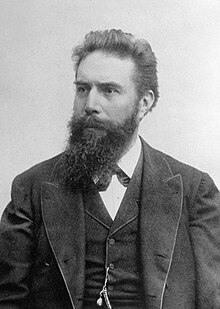Today we celebrate the discover of the X-Ray an important part of the electromagnetic spectrum.
I posted in this blog a several posts about radiation, with focus in the X-Rays. Now, Let's find out who discovered this radiation and how.
 Wilhelm Conrad Röntgen (27 March 1845 – 10 February 1923) was a German physicist, who, on 8 November 1895, produced and detected electromagnetic radiation in a wavelength range today known as X-rays or Röntgen rays, an achievement that earned him the first Nobel Prize in Physics in 1901. His experiments involved the passing of electric current through gases at extremely low pressure. On November 8, 1895 while he was experimenting, he observed that certain rays were emitted during the passing of the current through discharge tube. His experiment that involved working in a totally dark room with a well covered discharge tube resulted in the emission of rays which illuminated a barium platinocyanide covered screen. The screen became fluorescent even though it was placed in the path of the rays, two meters away from discharge tube.
Wilhelm Conrad Röntgen (27 March 1845 – 10 February 1923) was a German physicist, who, on 8 November 1895, produced and detected electromagnetic radiation in a wavelength range today known as X-rays or Röntgen rays, an achievement that earned him the first Nobel Prize in Physics in 1901. His experiments involved the passing of electric current through gases at extremely low pressure. On November 8, 1895 while he was experimenting, he observed that certain rays were emitted during the passing of the current through discharge tube. His experiment that involved working in a totally dark room with a well covered discharge tube resulted in the emission of rays which illuminated a barium platinocyanide covered screen. The screen became fluorescent even though it was placed in the path of the rays, two meters away from discharge tube. |
| earlier x-rays |
He continued his experiments using photographic plate to capture the image of various objects of random thickness placed in the path of the rays. He generated the very first “roentgenogram” by developing the image of his wife’s hand and analyzed the variable transparency as showed by her bones, flesh and her wedding ring. Based on his subsequent research and experiments, he declared that X-ray beams are produced by the impact of cathode rays on material objects.


No comments:
Post a Comment